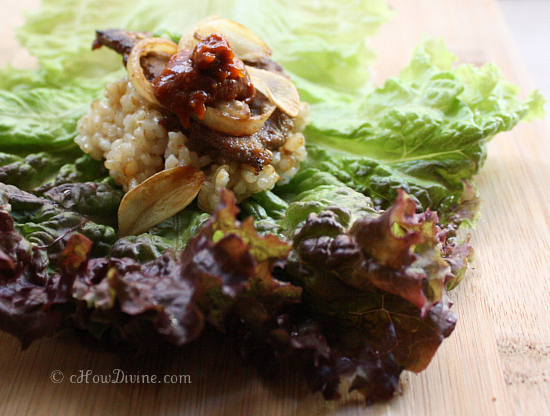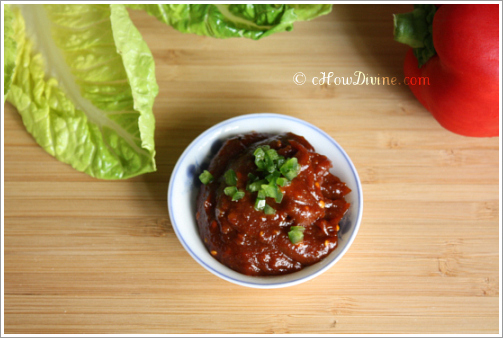Ssamjang directly translates to wrap sauce or wrap paste in Korean – “ssam” means wrap and “jang” means sauce or paste. Just as the name suggests, it’s a condiment commonly used when assembling Korean wraps. It is usually made with gochujang (Korean chili pepper paste) and doenjang (Korean soybean paste) as its base. But there are no rules when it comes to ssamjang. You can add anything to your heart’s desire. I’ve seen it made with lots of garlic, cooked minced meat, chopped sautéed mushrooms, crushed tofu, and so on. You can go wild. Really.
I had some marinated bulgogi in the refrigerator. And I was really craving some ssam (Korean lettuce wrap). I could have had it with gochujang sauce, but I wanted something different – a new treat for my palate. I decided to make some ssamjang.
I love garlic, roasted or sautéed/grilled garlic in particular. So I decided to make the ssamjang with some sesame oil-sautéed minced garlic. And I upped the garlic quotient by sautéing some sliced garlic for additional topping for my ssam. The result? Sublime…
Ssamjang Recipe
Ingredients
2 tbs doenjang or dark (or red) Japanese Miso
2 tbs gochujang
1 tsp garlic, minced
1 tsp toasted sesame seeds
2 tsp toasted sesame oil
½ tsp jalapeno pepper, minced: optional
1-2 TBs water: optional
- Add 1 tsp of toasted sesame oil and minced garlic into a small saucepan. Heat the saucepan over low-medium heat. Let it sizzle for a minute. Once the garlic becomes fragrant, add gochujang. Sauté mixture for 2-3 minutes. The gochujang should be bubbling (not burning!). Remove from heat.
- While the saucepan is still hot, add doenjang (or miso) and stir. Once it is well incorporated, add toasted sesame seeds and 1 tsp of the toasted sesame oil. Stir. Add water to thin out the sauce if desired. Add minced jalapeno pepper on top if using. (Those who want the extra spiciness can add jalapenos. And those who don’t, can leave it.)
- Serve with steamed rice, grilled meat or vegetables, and red leaf lettuce or sesame leaves. You can also serve with crudités as a dipping sauce.
Ssam Recipe
Ingredients
red leaf lettuce leaves
steamed brown or white rice
bulgogi
garlic cloves, sliced lengthwise
baechu (cabbage) kimchi
ssamjang
- Cook bulgogi according to recipe.
- Coat the bottom of a pan with canola or other cooking oil. Add sliced garlic to the pan. Heat the pan on medium heat. Once the garlic slices turn golden brown on the bottom-side, turn with tongs or chopsticks to finish cooking on the other side. (Once the pan heats up, it should take about a minute.) Remove from heat.
- Assemble the ssam by first adding a spoonful of steamed rice to the lettuce. Add bulgogi, slice of grilled garlic, piece of kimchi, and a dollop of ssamjang to the rice.
- “Wrap” by pulling up on the edges, in the shape of a drawstring purse. Put the whole ssam in your mouth! That’s the way the Koreans do it. Enjoy!





Wow, the sauce looks nice though I haven’t tried it before, looks like a killer sauce, would definitely wish to taste this. Yummy!!
Thanks! Pair it with something rich like bulgogi or even an avocado if you are a vegan, and wrap it with lettuce with a little bit of kimchi. It’s a real treat!
Wow. I really REALLY love Korean food and had some ‘ssam’ a few days ago. I had it with a doenjang and garlic combination, it was really good. Im going to try this next time for sure though. Could you help me out with a quick question? This evening I made some doenjang guk which was really good, but as I scrolled through recipes on the net, my doenjang soup was a much darker colour than that in recipes I came across. Does this mean there’s something wrong with my doenjang? Is it expired perhaps?
Hi Ndayola ~
No, not at all. It really depends on the doenjang/miso that you are using. There are many different types with varying colors. When my grandmother used to make doenjang at home, it would sometimes be lighter (closer to yellow), sometimes be redder, and other times darker. I also like to add a little bit of gochujang in the doenjang jjigae, which darkens the soup a bit as well.
If the darker color is the only reason why you are concerned about the quality of the doenjang, it should be fine.
Okay :]
Great.
?????!! ^^
kamsahabnida!! ^^
Chunmanaeyo! (You’re welcome 🙂 )
Hi, I’m really curious about sammjang, because in a korean restaurant I used to visit they serve this sammjang sauce which is a bit red and dark but not spicy, more like savory and they have some shreded soy bean or bean sprout inside.
Could you recommend what mixture is this. Love to eat chadolbaki & samgyupsal with the Sangchu Ssam.
Hi Ray! Chadolbaegi & samgyupsal with ssam sounds so good to me right now 🙂 The contents of ssamjang will differ depending on your preference. I think the shredded soy beans you are referring to is present in the doenjang. Some doenjang pastes are really smooth and some are lumpy with soy beans that have not been turned into paste. My family likes it a bit spicy. So I do a half mix of gochujang (Korean red chili pepper paste) and doenjang (Korean fermented soy bean paste). Some just use doenjang with garlic, sesame seeds, and other seasonings (even stir-fried ground meat!). But usually, it contains both chili paste and soy bean paste. You can also buy ssamjang from a Korean grocer. But I like making my own to suit my palate.
Try the recipe. Taste test it. If you want it a bit more spicy add some gochujang. If you think it’s too salty, add a tiny bit of water. If you want it sweeter, add a bit of sweetener. Adjust as you’d like. I hope you try out the recipe!
WOW thanks, I’ll try to mix it up.
Too bad that they do not export the Hanwoo beef. Well I could use wagyu as replacement I guess.
I just saw this on you FB page and thought to stop by anyways even if you posted few years go. I love ssam and your looks soooo delish…does it shows that I’m hungry at the moment lol!
Thanks Sandra! I’m always hungry for ssam. 😀 You should try ssamjang, if you haven’t already. It’s pretty adaptable (sweetness, saltiness, spiciness, etc). I hope you are doing well!